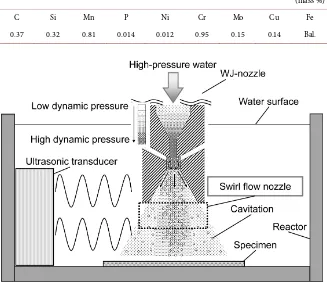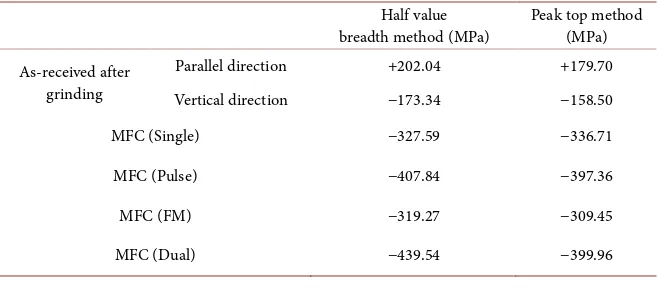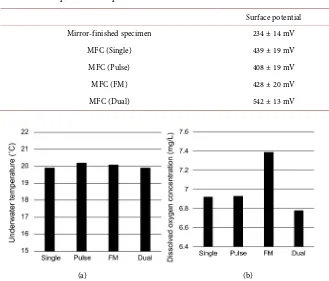ISSN Print: 2153-117X
DOI: 10.4236/msa.2018.98050 Jul. 11, 2018 698 Materials Sciences and Applications
Effect of Ultrasonic Irradiation Conditions on
Metal Surface during Multifunction Cavitation
Masataka Ijiri
*, Toshihiko Yoshimura
Sanyo-Onoda City University, Sanyo-Onoda, Japan
Abstract
Processing using multifunction cavitation (MFC) has recently enabled func-tional characteristics to be imparted to various materials. It is possible to process a material surface in the same manner as with conventional water jet (WJ) peening; however, the cavitation bubble temperature is different. To further improve this MFC technology, we examine the surface reforming of low alloy steel (JIS-SCM435) using MFC with various modes of ultrasonic waves. The ultrasonic equipment used for MFC processing includes dual, sin-gle, pulse and frequency modulation (FM) ultrasonic modes. Improvement of the residual stress and corrosion resistance was confirmed for all modes. The dual mode showed the maximum values of residual compressive stress and surface potential. The sound pressure at the machining spot was the highest with dual mode, and the temperature in the bubble generated by the WJ noz-zle was highest and the amount of dissolved oxygen was lowest. Improvement of the residual stress and corrosion resistance was promoted because the tem-perature and pressure in the bubble interior during processing was higher than in the other modes.
Keywords
Multifunction Cavitation, Residual Stress, Corrosion Resistance, Ultrasonic, Water Jet Peening
1. Introduction
Peening is a technique used to improve the fatigue strength and the stress corro-sion cracking resistance of metal parts, due to work hardening and plastic de-formation of the surface layer by strong tapping of the material surface. Water jet peening (WJP) [1] [2] [3] [4] [5] is a peening method that utilizes the cavita-tion phenomenon, and it is applied for preventive maintenance [2] in nuclear
How to cite this paper: Ijiri, M. and Yo-shimura, T. (2018) Effect of Ultrasonic Irradiation Conditions on Metal Surface during Multifunction Cavitation. Materials Sciences and Applications, 9, 698-704. https://doi.org/10.4236/msa.2018.98050
Received: May 21, 2018 Accepted: July 8, 2018 Published: July 11, 2018
Copyright © 2018 by authors and Scientific Research Publishing Inc. This work is licensed under the Creative Commons Attribution International License (CC BY 4.0).
DOI: 10.4236/msa.2018.98050 699 Materials Sciences and Applications
power plants. It is possible to reduce the tensile residual stress generated in a structure by welding or machining. When the WJP technique is applied to a structure, stress corrosion cracking [1] and metal fatigue [1] [6] can be pre-vented.
Cavitation jets occur in the WJP process when high-pressure water containing fine microscopic cavitation bubbles is injected. Cavitation bubbles are repeatedly produced in a turbulent flow within the surrounding water and generate an ex-tremely large impact force together with sound. The cavitation bubbles shrink at high speed due to the surrounding pressure, generate large shock waves and mi-crojets, and then disappear. WJP is a processing method that induces a small amount of plastic deformation of a material surface by this impact pressure. When a minute portion on the material surface is stretched and plastically de-formed, the deformed portion is elastically restrained from the surroundings, so that compressive residual stress is imparted to the impacted region. Therefore, when WJP is applied to a material surface where tensile residual stress remains, it is possible to change from tensile residual stress to compressive residual stress. However, when the residual stress is made compressive, it has been reported that voids and cracks tend to form inside the specimen due to the pressure increase applied to the surface with WJP [3] [4] [5].
Recently, Yoshimura et al. developed multifunction cavitation (MFC) [7]
processing, which is a cavitation technique that applies ultrasonic waves to WJP. It is possible to reform a material surface with MFC in the same way as with WJP. However, the cavitation bubble temperature with MFC is different; the sound pressure due to ultrasonication exceeds the break threshold [7] [8] [9] af-ter the bubbles from the WJ nozzle collide with the maaf-terial surface. Therefore, high-temperature, high-pressure cavitation that produces hot spots occurs by repeated isothermal expansion and adiabatic compression. If a cavitation bubble begins to collapse when it is approaching the specimen surface, the volume of the bubble decreases, and a microjet is formed that impacts the surface of the object. The impact force is large because of the high temperature (several thou-sand degrees Celsius) and high pressure (about 1000 MPa) inside the bubble. Various properties of MFC-processed materials have been reported to date [4] [5] [7] [8] [9] [10].
Here, to further improve the MFC technique, we investigate the surface mod-ification of low alloy steel (JIS-SCM 435) with MFC using different ultrasonic wave modes.
2. Materials and Methods
DOI: 10.4236/msa.2018.98050 700 Materials Sciences and Applications Figure 1 shows the MFC processing equipment, in which an ultrasonic transducer (WD-1200-28T, Honda Electronics Co., Ltd.) irradiates the water jet as it emerges from the nozzle. A swirl flow nozzle [11] was used at the tip of the WJ nozzle to increase the number and size of cavitation bubbles. The discharge pressure of the pump was about 35 MPa, the nozzle diameter was 0.8 mm, and the distance between the nozzle and the specimen was assumed to be 65 mm, which is considered as the second peak [12] with the highest cavitation-bubble density. Processing was performed in a tank (JIS-SUS310S) with dimensions of 41 × 44 × 60 cm. The output of the ultrasonic transducer was 1200 W and the nominal drive frequency was 28 kHz. This device has dual, single, pulse and frequency modulation (FM) ultrasonic modes, and all waveforms are sinusoidal. Dual mode switches between 25 kHz and 27 kHz every 10 Hz. The single-mode output is constant at 26 kHz. Pulse mode toggles between 26 and 26.5 kHz every 5 Hz. FM randomly switches between 25 and 27 kHz every 10 Hz. All processing times were 2 min.
[image:3.595.211.538.411.693.2]Residual stress was measured using an X-ray stress analyzer (MSF-3M, Rigaku Co., Ltd.) with the peak top method after measurement of the (211) strain be-tween lattice planes with the Cr Kα line generated at 30 kV - 10 mA. A region of 1 × 1 cm was measured. Tensile residual stress was taken to be positive and com-pressive residual stress was taken to be negative. The sound pressure was measured
Table 1. Chemical composition of SCM435.
(mass %)
C Si Mn P Ni Cr Mo Cu Fe
0.37 0.32 0.81 0.014 0.012 0.95 0.15 0.14 Bal.
Figure 1. MFC processing equipment for surface machining by WJ cavitation under
DOI: 10.4236/msa.2018.98050 701 Materials Sciences and Applications
with a sonic monitor (HUS-5 SUS, Honda Electronics Co., Ltd.). The corrosion resistance was evaluated by measuring the surface potential using a Kelvin probe force microscopy (KFM) system equipped with a multi-compatible miniature probe microscope (AFM5200S Hitachi High-Tech Sciences Co., Ltd.). The mea-surement area was 100 × 100 μm, and the value obtained by subtracting three lines by line analysis was averaged. The amount of dissolved oxygen (DO) in the water where cavitation occurred was measured 30 min after cavitation had be-gun using a portable dissolved oxygen meter (OM-71, Horiba, Ltd.).
[image:4.595.210.539.584.728.2]3. Results and Discussion
Table 2 shows the results of residual stress measurements. In the unprocessed material, tensile residual stress was found in the grinding direction and com-pressive residual stress was found in the vertical direction. Residual stress mea-surements after various types of processing were performed in the grinding di-rection. For all specimens, the tensile residual stress was converted to compres-sive residual stress. Dual mode produced the maximum residual stress, and the FM mode produced the minimum. Thus, the residual stress was significantly af-fected by the ultrasonic wave mode.
The relative sound pressure (expressed as a voltage) of the ultrasonic waves for each mode was measured at the WJ nozzle position (about 45 mm from the ultrasonic transducer): for pulse mode it was 8 - 9.5 mV, for single mode it was 11 - 13 mV, for FM mode it was 10 - 12 mV, and for dual mode it was 14 - 16 mV. The highest sound pressure was obtained with dual mode. The bubbles generated by the WJ that received this sound pressure had hot spots, which is considered to be why the largest residual compressive stress was produced. This hot spot phenomenon makes it very difficult to measure the temperature inside the bubble.
The oxide film formed on the specimen surface after each MFC process was measured using KFM to confirm the increase of the specimen surface tempera-ture, as shown in Table 3. KFM detects the displacement of a cantilever due to an electrostatic attractive force on the specimen surface; therefore, it is possible to obtain the work function difference (contact potential difference) between the
Table 2. Residual stress in specimens after various treatments.
Half value
breadth method (MPa) Peak top method (MPa) As-received after
grinding
Parallel direction +202.04 +179.70
Vertical direction −173.34 −158.50
MFC (Single) −327.59 −336.71
MFC (Pulse) −407.84 −397.36
MFC (FM) −319.27 −309.45
DOI: 10.4236/msa.2018.98050 702 Materials Sciences and Applications
probe and the specimen surface. The electrostatic force received by the probe from the fixed charge distributed on the specimen surface is detected to obtain the surface potential. Surface potential measurements are significantly affected by surface roughness; therefore, the specimen surfaces were polished to a mirror finish before MFC processing. The surface potential for the specimens processed under the various modes all increased relative to that for the unprocessed ma-terial, with dual mode showing the highest value. The increase in surface poten-tial is reported to be due to selective oxidation during MFC processing, so that an oxide film is likely to be formed on the specimen surface [10].
[image:5.595.209.538.412.693.2]To clarify the cause of surface oxidation, Figure 2 shows the results for water temperature and dissolved oxygen concentration in the water tank for each processing mode. Since both the water temperature and the dissolved oxygen con-centration varied initially, the measurements were performed after 30 minutes of processing to ensure stable values. The water temperature before processing was about 11˚C - 15˚C and the dissolved oxygen amount was about 11 - 12 mg/L. As a result of processing for 30 min, the water temperature increased and the dis-solved oxygen concentration decreased. Almost no difference in water tempera-ture was observed for the different ultrasonic modes. However, the decrease in the amount of dissolved oxygen was smallest in FM mode and largest in dual mode. These results indicate that alternating the frequency between 25 kHz and 27 kHz every 10 Hz as in dual mode generates high temperature and high pressure
Table 3. Surface potential for specimens after various MFC treatment for 2 min.
Surface potential
Mirror-finished specimen 234 ± 14 mV
MFC (Single) 439 ± 19 mV
MFC (Pulse) 408 ± 19 mV
MFC (FM) 428 ± 20 mV
MFC (Dual) 542 ± 13 mV
(a) (b)
Figure 2. (a) Underwater temperature; and (b) Amount of dissolved oxygen for different
DOI: 10.4236/msa.2018.98050 703 Materials Sciences and Applications
in the bubbles during processing. However, the cause of this phenomenon has yet to be clarified. In addition, besides the frequency change of the ultrasonic waves, the reactor which reflects the ultrasonic waves also influences the tem-perature and pressure inside the bubbles. It has been reported that the resonance conditions for a reactor depends on the water surface height and the water tem-perature, even if the frequency is constant [13]. Therefore, it will be necessary to further consider such factors in future work.
4. Conclusion
Improvement of residual stress and corrosion resistance was confirmed for all ultrasonic wave modes in MFC processing of Cr-Mo steel; however, dual mode showed the maximum values. In dual mode, the sound pressure at the machining spot was the highest, so that the temperature inside the bubbles from the WJ nozzle was the highest, and the amount of dissolved oxygen was the lowest. As a result, improvement of the residual stress and corrosion resistance was pro-moted because of the high-temperature and high-pressure in the bubble interior during processing.
Acknowledgements
This work was supported by the “Innovative Science and Technology Initiative for Security” program of the Acquisition, Technology & Logistics Agency (ATLA) of Japan.
References
[1] Hirano, K., Enomoto, K., Hayashi, E. and Kurosawa, K. (1996) Effects of Water Jet Peening on Corrosion Resistance and Fatigue Strength of Type 304 Stainless Steel.
Journal of the Society of Materials Science, 45, 740-745. https://doi.org/10.2472/jsms.45.740
[2] Saitou, N., Enomoto, K., Kurosawa, K., Morinaka, R., Hayashi, E., Ishikawa, T. and Yoshimura, T. (2003) Development of Water Jet Peening Technique for Reactor In-ternal Components of Nuclear Power Plant. Journal of Jet Flow Engineering, 20, 4-12.
[3] Ijiri, M., Shimonishi, D., Nakagawa, D. and Yoshimura, T. (2017) Evolution of Mi-crostructure from the Surface to The interior of Cr-Mo Steel by Water Jet Peening.
Materials Sciences and Applications, 8, 708-715. https://doi.org/10.4236/msa.2017.810050
[4] Ijiri, M. and Yoshimura, T. (2018) Evolution of Surface to Interior Microstructure of SCM435 Steel after Ultra-High-Temperature and Ultra-High-Pressure Cavitation Processing. Journal of Materials Processing Technology, 251, 160-167.
https://doi.org/10.1016/j.jmatprotec.2017.08.016
[5] Ijiri, M., Shimonishi, D., Nakagawa, D., Tanaka, K. and Yoshimura, T. (2017) Sur-face Modification of Ni-Cr-Mo Steel by Multifunction Cavitation. Journal of Mate-rials Science and Engineering A, 7, 290-296.
DOI: 10.4236/msa.2018.98050 704 Materials Sciences and Applications [7] Yoshimura, T., Tanaka, K. and Yoshinaga, N. (2016) Development of Mechani-cal-Electrochemical Cavitation Technology. Journal of Jet Flow Engineering, 32, 10-17.
[8] Yoshimura, T., Tanaka, K. and Yoshinaga, N. (2018) Nano-Level Material Processing by Multifunction Cavitation. Nanoscience & Nanotechnology-Asia, 8, 41-54. https://doi.org/10.2174/2210681206666160922164202
[9] Yoshimura, T., Tanaka, K. and Yoshinaga, N. (2016) Material Processing by Me-chanical-Electrochemical Cavitation. BHR Group, Hartford, 223-235.
[10] Ijiri, M. and Yoshimura, T. (2018) Improvement of Corrosion Resistance of Low-Alloy Steels by Resurfacing Using Multifunction Cavitation in Water. IOP Conference Series: Materials Science and Engineering, 307, Article ID: 012040. https://doi.org/10.1088/1757-899X/307/1/012040
[11] Ijiri, M., Shimonishi, D., Nakagawa, D. and Yoshimura, T. (2018) New Water Jet Cavitation Technology to Increase Number and Size of Cavitation Bubbles and Its Effect on Pure Al Surface. International Journal of Lightweight Materials and Man-ufacture, 1, 12-20. https://doi.org/10.1016/j.ijlmm.2018.03.003
[12] Yamauchi, Y., Soyama, H., Sato, K., Ikohagi, T. and Oba, R. (1994) Development of Erosion in High-Speed Submerged Water Jets. Transactions of the Japan Society of Mechanical Engineers, Series B, 60, 736-743. https://doi.org/10.1299/kikaib.60.736 [13] Nomura, S., Murakami, K. and Sasaki, Y. (2000) Streaming Induced by Ultrasonic


